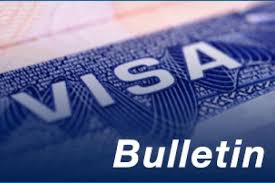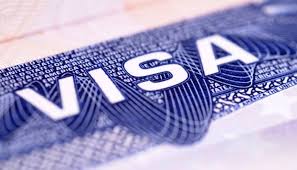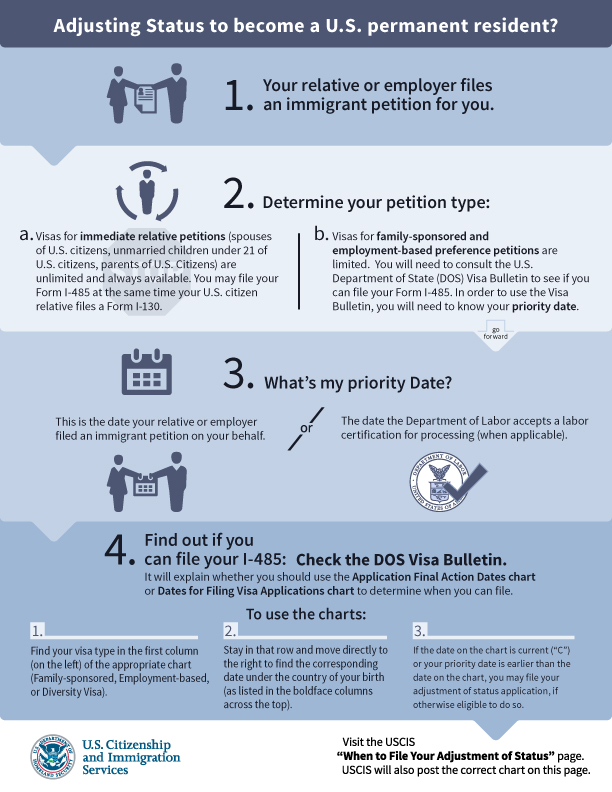 The Department of State released the visa bulletin for October 2016 recently. Below is a summary of movement and changes.
The Department of State released the visa bulletin for October 2016 recently. Below is a summary of movement and changes.
Family Based Immigrant Visa Numbers
F1 – Unmarried Sons and Daughters of US Citizens: This category moved forward about 1 week to September 22, 2090 for every country except Mexico (which moved forward 1 week to April 1, 1995 and the Philippines (which moved forward 1 week to August 1, 1995).
F2A – Spouses and children of Permanent Residents: All countries moved forward around 1 month, Mexico moved forward about 3 months to December 1, 2014. And the rest of the World moved forward about 5 weeks to December 22, 2014
F2B – Unmarried Sons and Daughters of Permanent Residents: Most of the world moved forward about 5 weeks to March 15, 2010. Mexico moved forward only 2 weeks to October 1, 1995 and the Philippines moved forward 1 month to January 1, 2006
F3 – Married Sons and Daughters of US Citizens: Most of the world moved forward about 3 weeks to December 22, 2004. Mexico moved forward about 1 week to November 22, 1994 and the Philippines moved forward about 3 weeks to July 8, 1994
F4 – Brothers and Sisters of US Citizens: China moved forward 4 months to May 1, 2003. India jumped just over 1 year to December 1, 2002. Mexico moved forward a couple weeks to May 1, 1997. The Philippines moved forward about 6 weeks to April 15, 1993. The rest of the world moved forward about 1 month to November 1, 2003
Predictions for coming months:
There should be forward movement on all categories in the next several months of about 2-6 weeks.
Employment Based Immigrant Visas
EB-1: As stated previously, this became current for everyone for October.
EB-2: Again, as we stated previously this became current for Worldwide numbers, Mexico and the Philippines. It moved forward to February 15, 2012 for China and to January 15, 2007 for India.
EB-3: Moved forward 1 month for Worldwide and Mexico to June 1, 2016. China jumped forward to January 22, 2013 (putting the EB-3 category ahead of the EB-2 for China). India Moved forward about 1 month to March 1, 2005 and the Philippines moved forward about 5 months to December 1, 2010.
Predictions for the Coming Months:
For EB-2s the Department of State sees China and India moving forward about 3 months (maybe 4 months for India) in the coming months. Worldwide and Mexico should remain current.
For EB-3s, they still feel that for the Worldwide numbers, demand may cause them to backlog (however this did not occur at all last year, and they thought it would then as well), but we will have to see. For China, EB-3 should move forward about 3 months. It will move forward only about 1 week for India and about 3 weeks for the Philippines.

 The Department of State (DOS) released the July visa bulletin recently and Charlie Oppenheim, the person at the DOS who is in charge of the visa bulletin also updated the American Immigration Lawyer’s Association on what further movement or backlogs can be expected in the near future.
The Department of State (DOS) released the July visa bulletin recently and Charlie Oppenheim, the person at the DOS who is in charge of the visa bulletin also updated the American Immigration Lawyer’s Association on what further movement or backlogs can be expected in the near future. USCIS has proposed a new fee structure – raising certain fees, keeping certain fees at their current level, and even lowering some fees.
USCIS has proposed a new fee structure – raising certain fees, keeping certain fees at their current level, and even lowering some fees. When you go in to USCIS to be interviewed for your I-485 application, it has been the practice for USCIS to take your EAD card at that time. Why did they develop this policy? Really who knows. It makes no sense as you are not yet approved and need the EAD to travel and work. Despite this, USCIS has routinely done these (they say only in cases that they are going to approved, but my experience is that they do this in every case).
When you go in to USCIS to be interviewed for your I-485 application, it has been the practice for USCIS to take your EAD card at that time. Why did they develop this policy? Really who knows. It makes no sense as you are not yet approved and need the EAD to travel and work. Despite this, USCIS has routinely done these (they say only in cases that they are going to approved, but my experience is that they do this in every case). The Department of State just came out with the Visa Bulletin for February 2016. Unfortunately there was not much movement on either the family or employment front. Below we summarize what movement there was.
The Department of State just came out with the Visa Bulletin for February 2016. Unfortunately there was not much movement on either the family or employment front. Below we summarize what movement there was.

 Just about 1 month ago I wrote a
Just about 1 month ago I wrote a  We have had clients contact us wanting to appeal the denial of their case by USCIS to the Administrative Appeals Office (AAO). Generally, our response to people is that appeals are extremely difficult to get approved, and usually not worth the money. However many people still want to appeal and there are certainly many attorneys out there who will appeal cases telling people that they have a “good chance” at winning the appeal. The question is, what are the actual chances of winning on appeal?
We have had clients contact us wanting to appeal the denial of their case by USCIS to the Administrative Appeals Office (AAO). Generally, our response to people is that appeals are extremely difficult to get approved, and usually not worth the money. However many people still want to appeal and there are certainly many attorneys out there who will appeal cases telling people that they have a “good chance” at winning the appeal. The question is, what are the actual chances of winning on appeal?